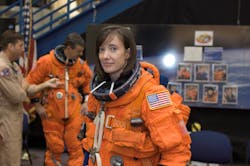NASA examining psychological benefits of growing plants on Space Station
It’s that every-so-often time again when LEDs Magazine has checked in once more with the International Space Station to learn the latest in LED horticultural lighting aboard the world’s highest-altitude inhabited scientific research station.
As we poked around for updates, we were struck by just how many plant-growing experiments are taking place some 220 miles above Earth. By its own tally, NASA itself is running seven different such studies on board. We’ve written about some of them (including a few linked in this story). Usually, solid-state lighting is involved, although we also uncovered one earlier this year by NASA’s Japanese counterpart, the Japan Aerospace Exploration Agency (JAXA), involving what astronaut Soichi Naguchi described as “just normal lighting.”
We will endeavor to bring you a summary of the seven NASA experiments in a subsequent article. The idea with all of them is to learn how to reliably grow edibles in microgravity and use them to feed and nourish people in outer space. NASA and kindred agencies from other countries are also picking up insights to apply on Earth.
For now, we will focus on a report from last week, when NASA blogger Deepthi Cauligi noted that several crew members participated in a study looking at the psychological benefits of growing plants in space.
“The crew...filled out questionnaires as part of the Human Research Facility Veg study, which focuses on the overall behavioral health benefits of having plants and fresh food in space,” Cauligi wrote.
The Human Research Facility Veg study is less concerned with studying specific crops — NASA astronauts are growing a variety under LED lights, including mizuna mustard greens and radishes, among others — but is more interested in the overall healthy mind possibilities.
“Growing fresh vegetables in space offers benefits beyond providing a source of nutrition to crew members,” explained Dr. Gioia Massa, project scientist at NASA’s Kennedy Space Center in Florida, NASA’s Deepthi Srinidhi and colleague Jennifer Turner wrote earlier this year when the project began. “Here on Earth, pandemic-induced isolation has led people to take up baking or gardening. Could developing a space-faring green thumb also help astronauts ease their sense of confinement and isolation? NASA’s Human Research Program, or HRP, has given Massa and her team of researchers the task of finding out.
“To learn more, Massa’s group is asking astronauts who currently cultivate vegetables on the station to each complete a survey about their space-gardening experiences. For example, crew members who grow mizuna mustards take the survey two to three times for the month-long growth cycle of the plant.
“Questions on the survey help gauge how space-gardening affects astronauts’ moods. For example: Was gardening engaging, demanding, or meaningful? Did it impact the passage of time, performance of mission tasks, or relationships with crew members? Did gardening enhance their connection to Earth, desire to harvest or consume the plants, or food consumption in general? How effective was gardening as a source of sensory stimulation for sight, touch, smell, and taste?
“When the vegetables are ready to eat, the astronauts also complete a sensory assessment. They rate the flavor, color, appearance, aroma, texture, and taste of the produce to see whether the labor over their veggies proved fruitful as a supplement to prepackaged space food.”
Last week, five astronauts participated in the survey, three from the US, one from JAXA and one from the European Space Agency.
Other astronauts have already filled out the survey. Massa hopes to assess a total of 24 of them.
“We are learning what crops to grow to help supplement the diet, which activities should be automated or remotely operated, and which should have options for crew involvement,” Massa said earlier this year. “Different growth systems and different space missions will have different solutions to these questions.”
MARK HALPER is a contributing editor for LEDs Magazine, and an energy, technology, and business journalist ([email protected]).
For up-to-the-minute LED and SSL updates, why not follow us on Twitter? You’ll find curated content and commentary, as well as information on industry events, webcasts, and surveys on our LinkedIn Company Page and our Facebook page.

Mark Halper | Contributing Editor, LEDs Magazine, and Business/Energy/Technology Journalist
Mark Halper is a freelance business, technology, and science journalist who covers everything from media moguls to subatomic particles. Halper has written from locations around the world for TIME Magazine, Fortune, Forbes, the New York Times, the Financial Times, the Guardian, CBS, Wired, and many others. A US citizen living in Britain, he cut his journalism teeth cutting and pasting copy for an English-language daily newspaper in Mexico City. Halper has a BA in history from Cornell University.





